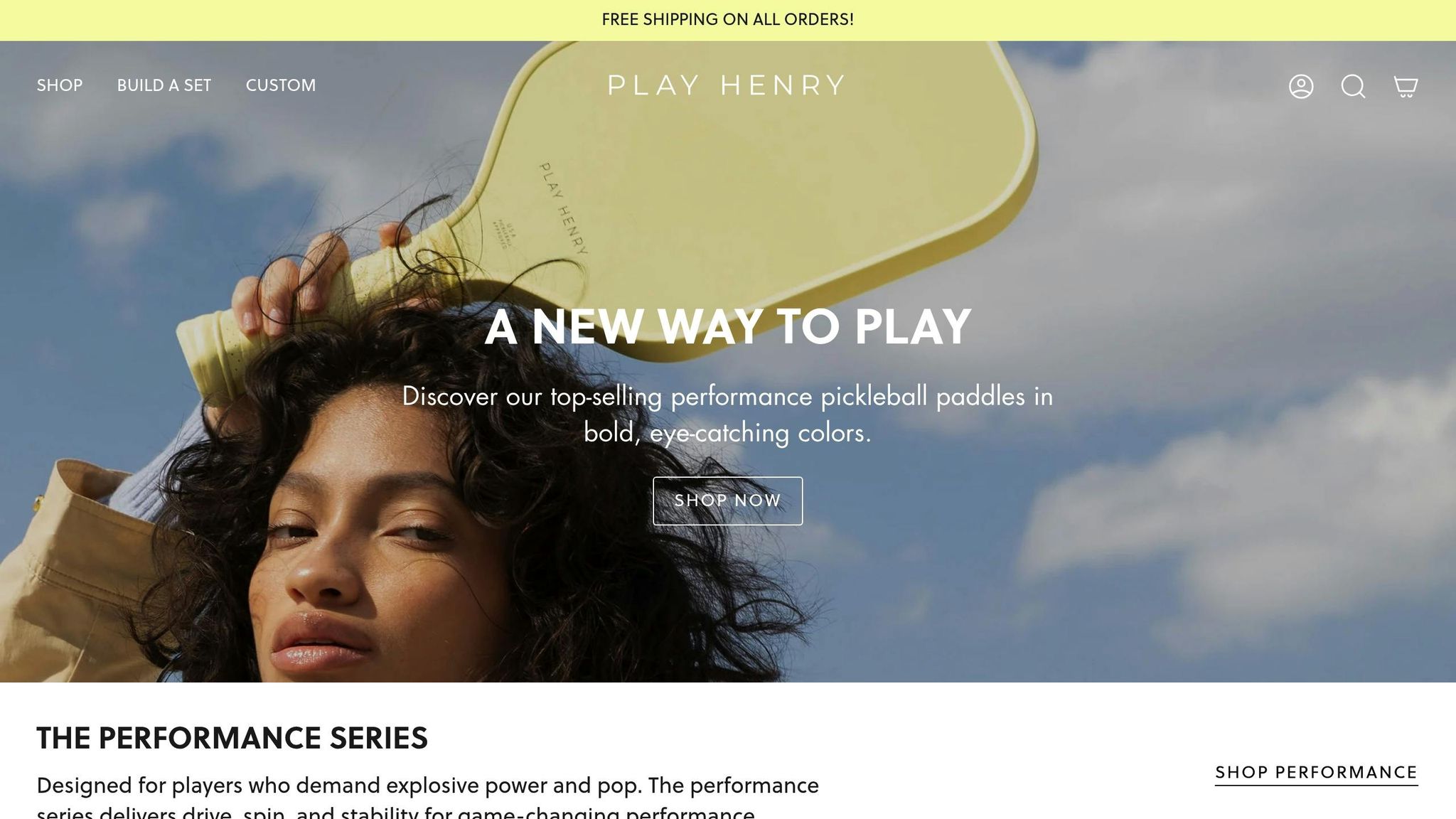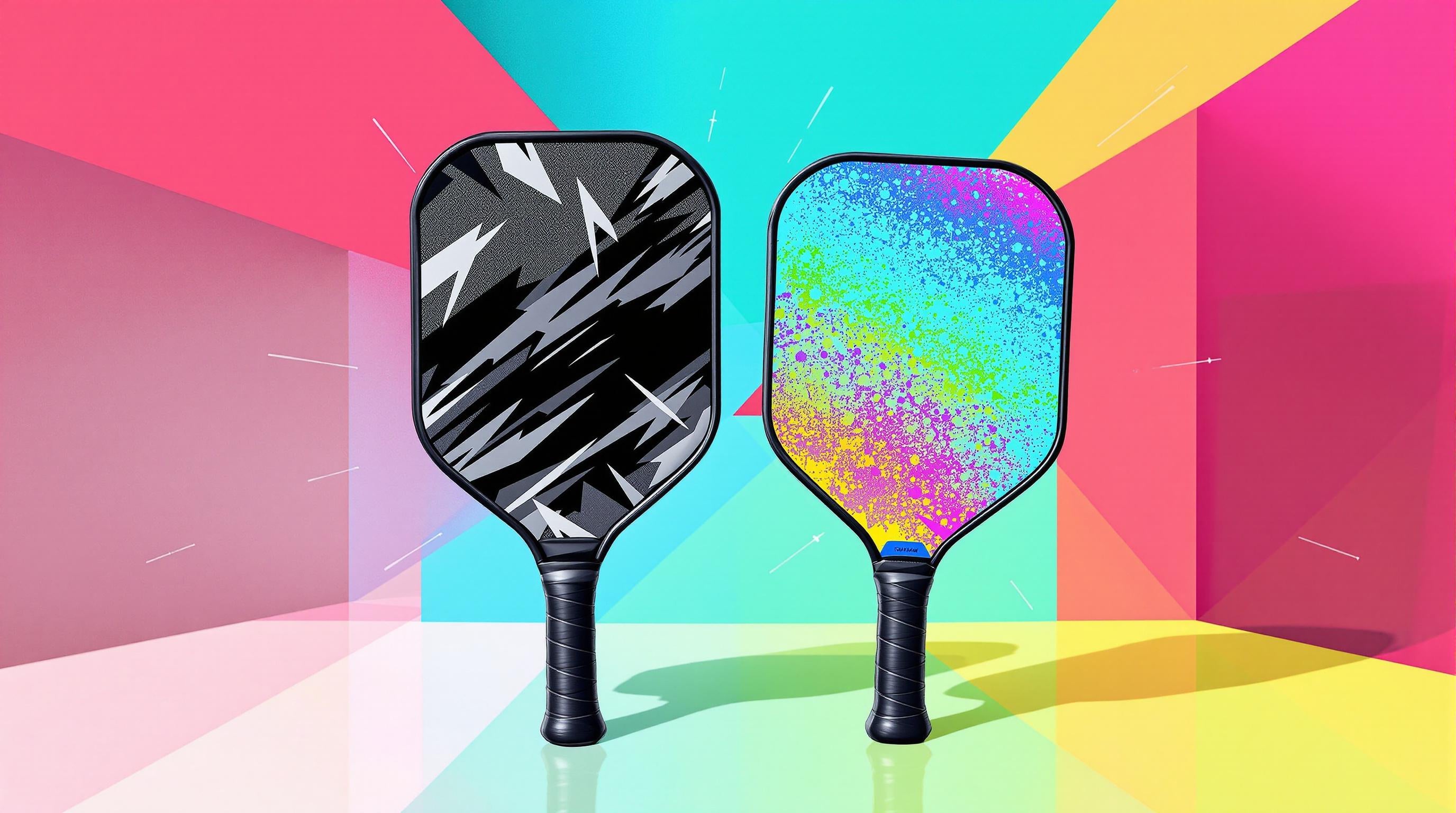Carbon fiber and fiberglass are two key materials used in pickleball paddles, each offering distinct advantages depending on your playing style and skill level. Here's a quick breakdown:
- Carbon Fiber: Lightweight, stiff, and powerful. Ideal for advanced players seeking precision and spin. It offers high durability and performs well in all weather conditions but comes at a higher cost.
- Fiberglass: Slightly heavier, flexible, and forgiving. Perfect for beginners and intermediate players refining their skills. It absorbs impact better but shows wear faster and is more affected by temperature changes.
Quick Comparison
| Feature | Carbon Fiber | Fiberglass |
|---|---|---|
| Weight | Lightweight | Slightly heavier |
| Power | High | Balanced |
| Control | Precise | Solid |
| Durability | Long-lasting | Reliable |
| Impact Resistance | Moderate | High |
| Price | Higher cost | Budget-friendly |
Choose carbon fiber for precision and power or fiberglass for comfort and affordability. Your choice should align with your skill level and playing style.
What's the best pickleball paddle material? | Is it worth it to ...
Carbon Fiber and Fiberglass Basics
Carbon Fiber Structure
Carbon fiber is a composite material made from extremely thin, strong crystalline filaments of carbon. These filaments, measuring just 0.005–0.010 mm in diameter, are woven together and combined with epoxy resin to create a strong yet lightweight material. In pickleball paddles, the alignment of carbon atoms along the fiber's length enhances the strength-to-weight ratio, allowing for efficient force transfer while keeping the paddle light.
Fiberglass Structure
Fiberglass is made from fine glass fibers woven into a textile-like material. To create these fibers, molten glass is drawn into thin strands, typically 0.015–0.025 mm in diameter, and treated with a special coating to bond effectively with resin. In pickleball paddles, fiberglass layers are often arranged in a cross-hatched pattern. This setup distributes impact forces evenly across the paddle surface, offering multi-directional strength.
Material Property Differences
The performance of a pickleball paddle can vary greatly depending on whether it uses carbon fiber or fiberglass. Here’s a quick comparison of their key properties:
| Property | Carbon Fiber | Fiberglass |
|---|---|---|
| Density | 1.6 g/cm³ | 2.5 g/cm³ |
| Tensile Strength | 3,500–7,000 MPa | 1,500–2,500 MPa |
| Stiffness | Very High | Moderate |
| Vibration Dampening | Low | High |
| Temperature Resistance | Up to 500°F | Up to 300°F |
| Impact Resistance | Moderate | High |
PLAY HENRY's carbon paddles use a specialized layering method to enhance power and control. Carbon fiber's stiffness makes it ideal for advanced players seeking powerful, precise shots. On the other hand, fiberglass offers a softer, more forgiving feel, which can help players refine their skills. Up next, we’ll dive into how these materials perform in real-world durability and strength tests.
Strength and Durability Tests
Strength and Stiffness
Carbon fiber is known for its high strength and stiffness, which helps paddles maintain their shape and improves energy transfer for more powerful returns. On the other hand, fiberglass is more flexible, giving players a softer, more forgiving feel during play.
Impact and Wear Resistance
Carbon fiber holds up well under repeated impacts, keeping its structure intact. However, its rigidity can sometimes mask internal damage from extreme impacts. Fiberglass, thanks to its natural elasticity, absorbs impacts better, reducing the chances of sudden breakage. That said, fiberglass tends to show visible wear more quickly over time. These differences also influence how each material handles varying weather conditions.
Weather and Temperature Effects
Weather plays a role in paddle performance. Carbon fiber paddles perform consistently across different conditions, making them a reliable choice for year-round use - like those offered by PLAY HENRY. Fiberglass paddles, however, can be more affected by significant temperature swings, so proper storage becomes important to maintain their performance.
Taking care of your paddle, no matter the material, ensures consistent performance on the court.
sbb-itb-c5e004d
Weight and Playing Style
Carbon Fiber Weight Advantages
Carbon fiber is known for its impressive strength-to-weight ratio, making it a great choice for paddles that are both lightweight and powerful. The lighter design improves control during fast-paced rallies and extended gameplay, making it ideal for quick volleys and reactive shots.
PLAY HENRY's Performance Series paddles take full advantage of carbon fiber construction, offering the perfect combination of speed and power for players who demand precision and agility.
Fiberglass Weight Advantages
Fiberglass paddles are generally heavier, which can help players generate more momentum on groundstrokes and drives. This added weight makes it easier to hit powerful shots with less effort, catering to those who prefer a more controlled approach. Plus, the forgiving nature of fiberglass paddles ensures a comfortable feel, encouraging proper technique.
These distinct weight differences help players select the paddle that aligns with their gameplay and skill level.
Matching Paddle Weight to Skill Level
The weight and material of a paddle play a key role in matching it to a player's skill level:
| Player Level | Recommended Material | Key Benefits |
|---|---|---|
| Beginner | Fiberglass | Provides a comfortable feel and helps develop proper technique |
| Intermediate | Either Material | Choice depends on personal playing style and needs |
| Advanced | Carbon Fiber | Enhances precision and reduces arm strain during intense play |
PLAY HENRY's Play Series paddles are designed for beginners and intermediates, offering balanced performance and comfort. Advanced players, on the other hand, will appreciate the Performance Series carbon fiber paddles for their ability to deliver quick reactions and precise control, perfect for an aggressive style of play.
This careful selection of materials also ties into production and pricing considerations.
Production and Price Factors
Price Range and Value
The production process directly impacts the pricing of PLAY HENRY products. The carbon fiber collection - which includes models like Espresso, Tomato, Butter, Sky, Bubblegum, Eclipse, and Matcha - is available for $98.00 each. On the other hand, the PLAY HENRY x Presley Goode series (Morning Dip and Sunset Sip) and Hank paddles are priced at $78.00 each.
Conclusion: Choosing Your Paddle Material
Material Comparison Summary
Here's a quick breakdown of key differences between carbon fiber and fiberglass paddles. Each material caters to different playing styles, offering distinct features that can influence your decision.
| Feature | Carbon Fiber | Fiberglass |
|---|---|---|
| Weight | Lightweight | Slightly heavier |
| Power | High power output | Balanced power |
| Control | Precise | Solid |
| Durability | Long-lasting | Reliable |
| Price | Higher cost | Budget-friendly |
These characteristics help players choose the paddle that best matches their skill level and play style.
Best Picks by Player Level
Your choice of paddle material can dramatically affect your game. Carbon fiber paddles are ideal for players seeking precision and power, while fiberglass paddles provide a balanced option at a lower cost. PLAY HENRY's paddle lineup offers options tailored to all skill levels, ensuring every player finds a match.
PLAY HENRY Carbon Paddle Features

PLAY HENRY's carbon fiber paddles are designed to enhance both control and power. With a reactive honeycomb core, these paddles deliver top-notch performance while staying durable. As one satisfied player shared:
"I absolutely LOVE this paddle! It makes me feel like a much stronger player. I love the design too! 10/10 recommend!"
Beyond performance, the paddles feature sleek, monochrome designs in colors like Pastel Pink, Sky Blue, and Espresso Brown - combining style and functionality for the court.

